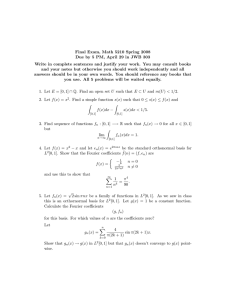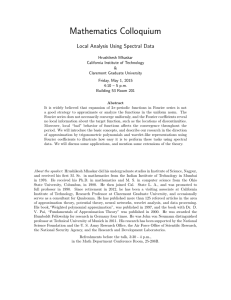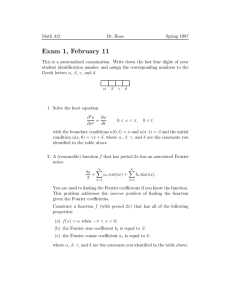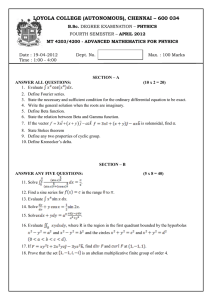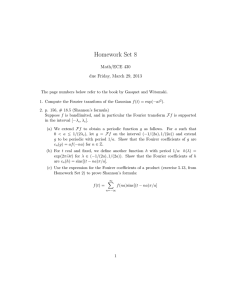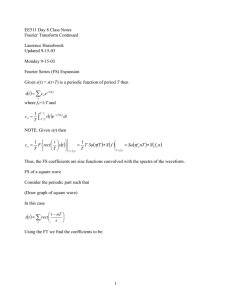On the convergence rate of a modified Fourier series
advertisement
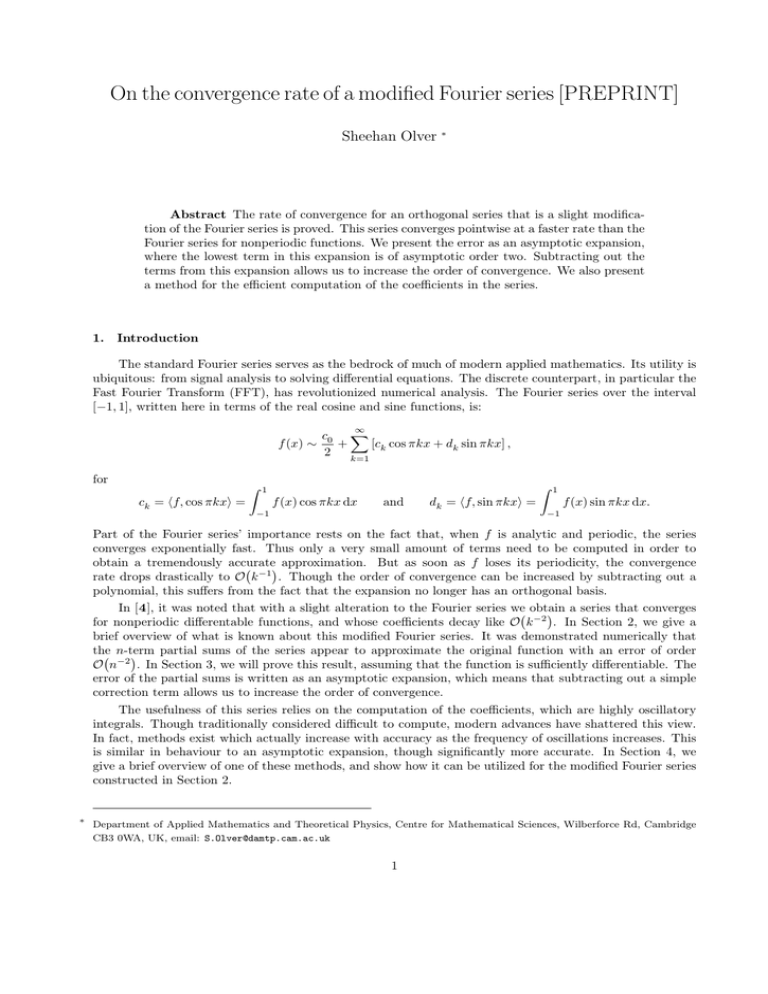
On the convergence rate of a modified Fourier series [PREPRINT]
Sheehan Olver ∗
Abstract The rate of convergence for an orthogonal series that is a slight modification of the Fourier series is proved. This series converges pointwise at a faster rate than the
Fourier series for nonperiodic functions. We present the error as an asymptotic expansion,
where the lowest term in this expansion is of asymptotic order two. Subtracting out the
terms from this expansion allows us to increase the order of convergence. We also present
a method for the efficient computation of the coefficients in the series.
1.
Introduction
The standard Fourier series serves as the bedrock of much of modern applied mathematics. Its utility is
ubiquitous: from signal analysis to solving differential equations. The discrete counterpart, in particular the
Fast Fourier Transform (FFT), has revolutionized numerical analysis. The Fourier series over the interval
[−1, 1], written here in terms of the real cosine and sine functions, is:
∞
f (x) ∼
c0 X
+
[ck cos πkx + dk sin πkx] ,
2
k=1
for
Z
ck = hf, cos πkxi =
1
Z
f (x) cos πkx dx
and
−1
dk = hf, sin πkxi =
1
f (x) sin πkx dx.
−1
Part of the Fourier series’ importance rests on the fact that, when f is analytic and periodic, the series
converges exponentially fast. Thus only a very small amount of terms need to be computed in order to
obtain a tremendously accurate approximation. But as soon as f loses its periodicity, the convergence
rate drops drastically to O k −1 . Though the order of convergence can be increased by subtracting out a
polynomial, this suffers from the fact that the expansion no longer has an orthogonal basis.
In [4], it was noted that with a slight alteration to the Fourier series we obtain
a series that converges
for nonperiodic differentable functions, and whose coefficients decay like O k −2 . In Section 2, we give a
brief overview of what is known about this modified Fourier series. It was demonstrated numerically that
the n-term
partial sums of the series appear to approximate the original function with an error of order
O n−2 . In Section 3, we will prove this result, assuming that the function is sufficiently differentiable. The
error of the partial sums is written as an asymptotic expansion, which means that subtracting out a simple
correction term allows us to increase the order of convergence.
The usefulness of this series relies on the computation of the coefficients, which are highly oscillatory
integrals. Though traditionally considered difficult to compute, modern advances have shattered this view.
In fact, methods exist which actually increase with accuracy as the frequency of oscillations increases. This
is similar in behaviour to an asymptotic expansion, though significantly more accurate. In Section 4, we
give a brief overview of one of these methods, and show how it can be utilized for the modified Fourier series
constructed in Section 2.
∗
Department of Applied Mathematics and Theoretical Physics, Centre for Mathematical Sciences, Wilberforce Rd, Cambridge
CB3 0WA, UK, email: S.Olver@damtp.cam.ac.uk
1
2.
Modified Fourier series
This section is based on material found in [4]. Consider for a moment the standard Fourier series. When
f is sufficiently differentiable, we can determine the order of decay of the coefficients with a straightforward
application of integration by parts:
Z 1
1
(−1)k 0
0
[f
(1)
−
f
(−1)]
−
f 00 (x) cos πkx dx = O k −2 ,
2
2
(πk)
(πk) −1
−1
Z 1
k+1
(−1)
1
dk =
[f (1) − f (−1)] +
(2.1)
f 0 (x) cos πkx dx = O k −1 .
πk
πk −1
Interestingly, only the sine terms decay like O k −1 ; the cosine terms decay at the faster rate of O k −2 .
Indeed, if f is even, then all the sine terms are zero and the rate of convergence increases. In the construction
of the modified Fourier series, we replace the sine terms with an alternate basis such that the
orthogonal
property is still maintained, whilst the order of decay of the coefficients is increased to O k −2 .
Consider expansion in the series
ck = −
1
πk
Z
1
f 0 (x) sin πkx dx =
f (x) ∼
∞
c0 X +
ck cos πkx + sk sin π k − 21 x ,
2
k=1
where
Z
ck = hf, cos πkxi =
1
f (x) cos πkx dx
and
−1
1
2
sk = f, sin π k − x =
Z
1
f (x) sin π k −
−1
1
2
x dx.
We will denote the n-term partial sum of this series as fn :
fn (x) =
n
c0 X +
ck cos πkx + sk sin π k − 21 x .
2
k=1
Like the standard Fourier series, it can be shown that the basis functions of this series are orthogonal. This
follows since they are the eigenfunctions of the differential equation
u00 + α2 u = 0,
0 = u0 (1) = u0 (−1).
Unlike the Fourier series, the new sine terms are not periodic with respect to the interval [−1, 1], hence we
can consider this series for approximating nonperiodic functions.
If f ∈ C 2s [−1, 1] and f (2s) has bounded variation, then Theorem 13.2 in [8] tells us that
Z 1
f (2s) (x)eiπkx dx = O k −1 .
−1
In this case the asymptotic expansion for the coefficients can be found by repeatedly integrating by parts in
the same manner as in (2.1), giving us, for k 6= 0:
ck =
sk =
s
X
(−1)k+j+1 h
j=1
s
X
j=1
(πk)2j
i
f (2j−1) (1) − f (2j−1) (−1) + O k −2s−1 ,
h
i
(−1)k+j
(2j−1)
(2j−1)
f
(1)
+
f
(−1)
+ O k −2s−1 .
2j
(π(k − 1/2))
(2.2)
The cosine terms ck are the exact same as in the standard Fourier series, hence still decay like
O k −2 .
The new sine terms sk , unlike the standard Fourier series sine terms dk , also decay like O k −2 . Since the
coefficients go to zero at a faster rate, it stands to reason that the series itself will converge to the actual
function more rapidly than the standard Fourier series. This will be proved to be the case in Section 3.
In order to prove the rate of convergence, we first need to know that the series does indeed converge
pointwise. This is not trivial, but thankfully was proved in [4]:
2
0.008
0.032
0.006
0.0315
0.004
0.031
0.002
0.0305
20
40
60
80
100
n
20
40
60
80
100
n
√
√ Figure 1: For f (x) = Ai (x), the error f (−1/ 2) − fn (−1/ 2) scaled by n2 (left graph) and the error
|f (1) − fn (1)| scaled by n (right graph).
Theorem 2.1 [4] The modified Fourier series forms an orthonormal basis of L2 [−1, 1].
Theorem 2.2 [4] Suppose that f is a Riemann integrable function in [−1, 1] and that
n → ∞.
ck , sk = O n−1 ,
If f is Lipshitz at x ∈ (−1, 1), then
fn (x) → f (x).
The convergence at the endpoints in [4] was proved only for the case when f is analytic. Thus we present
an alternate proof that enlarges the class of functions such that pointwise convergence is known:
Theorem 2.3 Suppose that f ∈ C 2 [−1, 1] and f 00 has bounded variation. Then
fn (±1) → f (±1).
Proof :
We know that the coefficients of the series decay like O k −2 , thus
∞
X
(|ck | + |sk |) < ∞
k=1
and fn converges uniformly to a continuous function. Two continuous functions that differ at a single point
must differ in a neighbourhood of that point. The theorem thus follows from Theorem 2.2, since f is Lipshitz
everywhere.
Q.E.D.
We can demonstrate the accuracy of this expansion numerically. Consider the Airy function Ai (x) [1].
Since the turning point of the Airy function is within [−1, 1], it behaves very differently on the negative
segment of the interval than it does on the positive segment. Despite this difficulty, we can still approximate
the function efficiently. This
√ can be seen in Figure 1, which demonstrates the error of the n-term partial sum
fn at the points x = −1/ 2 and x = 1. We intentially chose an irrational number to demonstrate generality,
as the proof of the convergence rate relies on a special function
that has a simpler form at rational points.
As can be seen, the error does appear to decay like O n−2 at the chosen interior point, while at the reduced
rate of O n−1 at the right endpoint.
As another example, consider the function f (x) = 2/(7 + 20x + 20x2 ). This function suffers from
Runge’s phenomenon [10], where the successive derivatives of f grow very large within the interval of
approximation, which makes the function notoriously difficult to approximate. Figure 2 shows that the
modified Fourier series is still very accurate, and compares its accuracy to that of the standard Fourier
series. We see the error of the partial sums over the entire interval, for four choices of n. As can be seen,
3
5
10
0.035
0.03
0.025
0.02
0.015
0.01
0.005
!1
0.5
!0.5
0.14
0.12
0.1
0.08
0.06
0.04
0.02
!1
1
!1
!0.5
0.006
0.002
0.004
0.0015
0.5
1
!1
!1
1
!1
!0.5
20
0.12
0.1
0.08
0.06
0.04
0.02
0.12
0.1
0.08
0.06
0.04
0.02
1
0.001
0.0005
0.5
!0.5
10
0.5
0.0025
0.002
!0.5
5
60
20
0.008
0.015
0.0125
0.01
0.0075
0.005
0.0025
0.5
!0.5
1
!1
!0.5
0.5
1
0.5
1
60
0.12
0.1
0.08
0.06
0.04
0.02
0.5
1
!1
!0.5
Figure 2: For f (x) = 2/(7 + 20x + 20x2 ), the error |f (x) − fn (x)| (top graphs), versus the error of the
n-term partial sums of the Fourier series (bottom graphs), for n = 5, 10, 20, 60.
the modified Fourier series approximates inside the interior of the interval significantly better than it does
at the endpoints. With as little as 60 terms we obtain an error of about 2 × 10−5 around zero, compared
to an error of about 10−3 for the standard Fourier series. Furthermore, unlike the standard Fourier series,
there is no Gibbs’ phenomenon at the boundary points.
3.
Convergence rate
Though [4] proves the convergence
of the modified Fourier series, and demonstrates numerically that it
converges at a rate of O n−2 , it fails to prove this convergence rate, even for the case where f is analytic. In
this section, we present a proof for the case when f ∈ C 2 [−1, 1] and f 00 has bounded variation. Furthermore,
we prove this result in such away that, assuming sufficient differentiability of f , we know explicitly the error
term that decays like O n−2 , meaning we can actually increase the order of approximation by subtracting
out this term. In fact, if f is smooth, we can expand the error f (x)−fn (x) in terms of an asymptotic expansion
for n → ∞, meaning by subtracting out a correction term we can increase the order of approximation to be
arbitrarily high. This expansion even holds valid at the endpoints of the interval.
The proof involves writing the error itself in terms of its modified Fourier series, replacing the coefficients
of this series by the first s-terms of their asymptotic expansions, and using a known special function, in particular the Lerch transcendent function Φ [11], to rewrite the resulting infinite sum. The Lerch transcendent
function is defined as
∞
X
zk
Φ(z, s, m) =
.
(k + m)s
k=0
We begin by defining a couple key properties of the asymptotics of Φ:
Lemma 3.1 Suppose that s ≥ 2 and define
σx,s (t) =
ts−1
.
1 + eiπx−t
If −1 < x < 1, then
∞
Φ −eiπx , s, m ∼
(k−1)
1 X σx,s (0)
,
Γ(s)
mk
m → ∞.
k=s
If x = ±1, then
Φ(1, s, m) ∼
∞
(k−1)
1 X
σx,s (t)
lim
,
t→0
Γ(s)
mk
k=s−1
4
m → ∞.
Proof :
0
We first consider the case where −1 < x < 1. It is clear that 0 = σx,s (0) = σx,s
(0) = · · · =
(s−2)
σx,s (0). We know from [11] that, whenever −eiπx 6= 1, the Lerch transcendent function has the integral
representation
Z ∞
ts−1
1
e−mt dt.
Φ(z, s, m) =
Γ(s) 0 1 − ze−t
Furthermore,
Z
∞
(k)
σx,s
(t)e−mt dt =
0
1
1 (k)
σ (0) +
m x,s
m
∞
Z
(k+1)
σx,s
(t)e−mt dt.
0
The first part of the theorem thus follows from induction, since
Z ∞
Φ −eiπx , s, m =
σx,s (t)e−mt dt.
0
For the case when x = ±1, hence −eiπx = 1, the Lerch transcendent reduces to the Hurwitz zeta
function: Φ(1, s, m) = ζ(s, m) [1]. This has the same integral representation, however a singularity is now
introduced at zero:
Z ∞ s−1
Z ∞
t
1
1
−mt
e
dt
=
σ±1,s (t)e−mt dt.
ζ(s, m) =
Γ(s) 0 1 − e−t
Γ(s) 0
With a bit of care, however, we can integrate by parts in the same manner. For this choice of x
σ±1,s (t) =
ts−1
,
1 − e−t
hence, due to L’Hôpital’s rule, only the first s − 3 derivatives of σ±1,s vanish at zero. But σ±1,s is still C ∞
at zero, since
ts−1
ts−1
ts−2
σ±1,s (t) =
=
=
.
1 − e−t
t(1 + O(t2 ))
1 + O(t2 )
Thus integration by parts gives us its asymptotic expansion.
Q.E.D.
With the Lerch transcendent function in hand, we can successfully find the asymptotic expansion for
the error of the modified Fourier series:
Theorem 3.2 Suppose that f ∈ C 2s [−1, 1] and f (2s) has bounded variation. Then
f (x) − fn (x) = Es,n (x) + O n−2s ,
for
Es,n (x) =
s
X
(−1)j+n
2π 2j
j=1
"
f
(2j−1)
(1) − f
(2j−1)
eiπ(n+1)x Φ −eiπx , 2j, n + 1
(−1)
−iπ(n+1)x
−iπx
+e
Φ −e
, 2j, n + 1
1
+ i f (2j−1) (1) + f (2j−1) (−1)
eiπ(n+ 2 )x Φ −eiπx , 2j, n + 12
−e
5
1
−iπ(n+ 2 )x
Φ −e
−iπx
, 2j, n +
1
2
#
.
Proof :
Note that
∞
X
f (x) − fn (x) =
ck cos πkx + sk sin π k − 21 x .
k=n+1
This follows from the pointwise convergence of the modified Fourier series. We define the following two
constants for brevity:
f (2j−1) (1) − f (2j−1) (−1)
f (2j−1) (1) + f (2j−1) (−1)
,
ASj =
.
2j
2π
2iπ 2j
Substituting in the asymptotic expansion for the coefficients (2.2), the error of the partial sum is equal to
"
∞
s
X
X
(−1)k iπkx
j+1
AC
f (x) − fn (x) =
(−1)
(e
+ e−iπkx )
j
2j
k
j=1
k=n+1
#
∞
∞
X
X
1
1
(−1)k
iπ(k− 2 )x
−iπ(k− 2 )x
S
(e
−
e
)
+
O k −2s−1
− Aj
2j
1
k=n+1 k − 2
k=n+1
"
(
)
∞
∞
s
X
X
X
(−1)k
(−1)k
C
iπ(n+1)x
j+n
iπkx
−iπ(n+1)x
−iπkx
Aj e
=
(−1)
e
+e
e
(k + n + 1)2j
(k + n + 1)2j
j=1
k=0
k=0
)#
(
∞
∞
X
X
1
1
(−1)k
(−1)k
−iπ(n+ 2 )x
iπ(n+ 2 )x
S
iπkx
−iπkx
−e
− Aj e
e
e
1 2j
1 2j
k=0 k + n + 2
k=0 k + n + 2
+ O k −2s
AC
j =
By replacing the infinite sums with their Lerch transcendent function equivalent, we obtain
"
s
n
X
o
j+n
f (x) − fn (x) =
(−1)
AC
eiπ(n+1)x Φ −eiπx , 2j, n + 1 + e−iπ(n+1)x Φ −e−iπx , 2j, n + 1
j
j=1
−
ASj
e
1
iπ(n+ 2 )x
Φ −e
iπx
, 2j, n +
1
2
−e
1
−iπ(n+ 2 )x
Φ −e
−iπx
, 2j, n +
1
2
#
+ O k −2s .
Q.E.D.
Remark : If f ∈ C 2s+1 [−1, 1] in the preceding theorem, then the order of the error term increases to
O n−2s−1 . This follows since we can integrate by parts once more in the asymptotic expansion of the
coefficients, meaning the s-term expansion now has an order of error O n−2s−2 . We could have also written
the cosine and sine functions as the real and imaginary parts of eix , which would have resulted in two less
evaluations of the Lerch transcendent function.
We could substitute the Lerch transcendent functions in this theorem with the asymptotic expansion
found in Lemma 3.1, which results in an asymptotic expansion for the error in terms of elementary functions. Unfortunately this expansion explodes near the endpoints, even though another expansion in terms
of elementary functions is known at the endpoints. Thus, since the Lerch transcendent functions can be
computed efficiently [2], it is preferred to leave the Lerch transcendent functions in their unexpanded form.
As a result of this theorem, we obtain a sufficient condition for obtaining a rate of convergence of order
two:
Corollary 3.3 Suppose that f ∈ C 2 [−1, 1] and f 00 has bounded variation. If −1 < x < 1, then
f (x) − fn (x) = O n−2 .
Otherwise,
f (±1) − fn (±1) = O n−1 .
6
0.012
0.01
0.008
0.006
0.004
0.002
0.0005
0.004
0.0003
0.002
0.0002
0.0001
0.001
20
40
60
80
100
n
0.00014
0.00012
0.0001
0.00008
0.00006
0.00004
0.0004
0.003
10
20
30
40
50
60
70
n
20
40
60
80
100
n
20
40
60
80
100
√
√
√ Figure 3: For f (x) = Ai (x), the error f (−1/ 2) − fn (−1/ 2) − E1,n (−1/ 2) scaled by n4 (first graph),
√
√
√
f (−1/ 2) − f (−1/ 2) − E (−1/ 2) scaled by n6 (second graph), f (1) − f (1) − E (1) scaled by
n
2,n
n
1,n
n3 (third graph) and f (1) − fn (1) − E2,n (1) scaled by n5 (last graph).
5
10
0.00007
0.00006
0.00005
0.00004
0.00003
0.00002
0.00001
0.006
0.005
0.004
0.003
0.002
0.001
!1
0.5
!0.5
1
!1
5
!0.5
0.5
1
!1
!0.5
60
3.5 " 10!7
3 " 10!7
2.5 " 10!7
2 " 10!7
1.5 " 10!7
1 " 10!7
5 " 10!8
8 " 10!6
6 " 10!6
4 " 10!6
2 " 10!6
0.5
1
!1
10
0.000035
0.00003
0.000025
0.00002
0.000015
0.00001
5 " 10!6
0.006
0.005
0.004
0.003
0.002
0.001
!1
!0.5
20
0.00001
0.5
!0.5
1
!1
!0.5
20
1.5 " 10
4 " 10!11
5 " 10!9
!0.5
1
6 " 10!11
1 " 10!8
!1
0.5
8 " 10!11
!8
1
1
1 " 10!10
2 " 10!8
0.5
0.5
60
2 " 10!11
0.5
1
!1
!0.5
Figure 4: For f (x) = 2/(7 + 20x + 20x2 ), the error f (x) − fn (x) − E1,n (x) (top graphs) and the error
f (x) − f (x) − E (x) (bottom graphs), for n = 5, 10, 20, 30.
n
2,n
Proof : This corollary follows immediately by combining Theorem 3.2 with the asymptotic behaviour of Φ
found in Lemma 3.1.
Q.E.D.
As an example, consider again the function Ai (x). In Figure 3, we demonstrate that subtracting out
the error term Es,n (x) does indeed increase the order of approximation. In the first two graphs of this figure,
√
we see that this is true for the interior point x = −1/ 2, where subtracting out E1,n (x) increases the order
to n4 and subtracting out E2,n (x) increases the order further to n6 . In the second graph we end the data
at n = 60, as we have already reached machine precision. Since Ai (x) is analytic, we could continue this
process to obtain arbitrarily high orders. The last two graphs show that we can employ the same technique
at the boundary point x = 1, where the order is first increased to n3 , then to n5 .
We can see how subtracting out the first term in the error expansion affects the approximation over
the entire interval. In Figure 4, we return to the example first presented in Figure 2, where f (x) =
2/(7 + 20x + 20x2 ). As can be seen, we obtain incredibly more accurate results. When we remove the
first error term E1,n , by n = 10 the approximation is about the same as n = 60 without the small alteration,
and significantly more accurate at the boundary. Subtracting out the next term in the error expansion sees
an equally impressive improvement of accuracy, where with n = 30 we have at least eight digits of accuracy
throughout the interval, and nine digits within the interior.
4.
Computation of series coefficients
Up until now we have avoided computing the coefficients ck and sk of the modified Fourier series; we
merely assumed that they were given. When the function f is well-behaved, i.e., nonoscillatory, the first
few coefficients are well-behaved integrals, meaning standard quadrature methods such as Gauss-Legendre
quadrature will approximate these integrals efficiently. As k becomes large, the coefficients become highly
7
n
oscillatory integrals, and the standard methods are no longer efficient. With a bit of finesse, we can successfully compute these integrals in an efficient manner. In fact, using the correct quadrature methods, the
accuracy improves as the frequency of oscillations increases.
The most well-known solution for approximating highly oscillatory integrals is to use the asymptotic
expansion, which we have already derived in (2.2). Using a partial sum of the expansion, we obtain an
approximation which is more accurate when the frequency of oscillations is large. In fact, when f is sufficiently
differentiable, we can obtain an approximation of arbitrarily high asymptotic order. Unfortunately, the
asymptotic expansion does not in general converge for fixed values of k, meaning that the accuracy of this
approximation is limited.
To combat this problem we will use Levin-type methods, which were developed in [9] based on results
found in [7]. We consider integrals of the form
Z 1
Iω [f ] =
f (x)eiωx dx,
−1
whose real and imaginary parts can be used to compute ck and sk :
ck = Re Iπk [f ],
sk = Im Iπ(k−1/2) [f ].
Suppose that we have a function F such that
L[F ] = f,
Since
d
iωx
]
dx [F (x)e
L[F ] = F 0 + iωF.
for
= L[F ] (x)eiωx , it follows that
Z
Iω [f ] = Iω [L[F ]] =
1
d
[F (x)eiωx ] dx = F (1)eiω − F (−1)e−iω .
dx
−1
Finding such a function F exactly is as difficult as solving the integral explicitly, however, we can use collocation to approximate it. Assume we are given a P
sequence of nodes {x1 , . . . , xν }, multiplicities {m1 , . . . , mν }
ν
and basis functions {ψ1 ,P
. . . , ψν }. Then, for n = k=1 mk , we determine the coefficients ck for the approxin
mating function v(x) = k=1 ck ψk (x) by solving the system
(mk −1)
L[v] (xk ) = f (xk ), . . . , L[v]
(xk ) = f (mk −1) (xk ),
k = 1, . . . , ν.
It turns out that this decays at the same order as the partial sums of the asymptotic expansion:
Theorem 4.1 Suppose that f ∈ C r [−1, 1], f (r) has bounded variation and that {ψ1 , . . . , ψν } can interpolate
at the given nodes and multiplicities. Then
−s−1
Iω [f ] − QL
,
ω [f ] = O ω
for s = min {m1 , mν , r} and
Proof :
iω
−iω
QL
.
ω [f ] = v(1)e − v(−1)e
From the proof of Theorem 4.1 in [9] we know that L[v] and all its derivatives are O(1). Note that
(s−1)
L[v] (±1) = f (±1), · · · , L[v]
(±1) = f (s−1) (±1).
Thus the first s terms in the asymptotic expansion of Iω [f − L[v]] are zero and
Z 1
(s)
(s)
−s
(s)
iωx
−s
(s)
Iω [f ] − QL
[f
]
=
I
[f
−
L[v]]
=
(−iω)
f
−
L[v]
e
dx
=
(−iω)
I
[f
]
−
I
[L[v]
]
.
ω
ω
ω
ω
−1
−1
The integral Iω [f (s) ] behaves like O ω
since f (s) has bounded variation, while integrating by parts once
(s)
more reveals that Iω [L[v] ] also behaves like O ω −1 .
Q.E.D.
8
6 ! 10"6
5 ! 10"6
4 ! 10"6
3 ! 10"6
2 ! 10"6
1 ! 10"6
6 ! 10"6
5 ! 10"6
4 ! 10"6
3 ! 10"6
2 ! 10"6
1 ! 10"6
50 100 150 200 250 300
n
20
40
60
80
100
n
√
√ Figure 5: The error f (−1/ 2) − fnL (−1/ 2) (left graph) with endpoints for nodes and multiplicities both
√
√
two (top), nodes −1, − 3/2, 0, 3/2, 1 and multiplicities {2, 1, 1, 1, 2} (middle) and endpoints for nodes
√
√
√ and multiplicities both three (bottom), versus the error f (−1/ 2) − fnL (−1/ 2) − E1,n (−1/ 2) with the
same choices of Levin-type methods (right graph).
The conditions on this theorem are satisfied whenever {ψ1 , . . . , ψν } is a Chebyshev set, for example the
standard polynomial basis. This theorem lets us obtain an approximation with the same asymptotic order
as the asymptotic expansion, but significantly more accurate.
This leaves us with the slight problem of how to decide when to use oscillatory quadrature methods
and when to use nonoscillatory quadrature methods. We avoid investigating this problem as it is too
tangential to the subject of this paper. Instead, in our example, we compute the coefficients c0 , . . . , c3
and s1 , . . . , s3 to machine precision using Gauss-Legendre quadrature, and compute the other coefficients
with three different Levin-type methods. A more sophisticated quadrature method exists, namely exotic
quadrature [3], which reuses the information already obtained for a Levin-type method to approximate the
nonoscillatory coefficients. For simplicity, we will use the standard polynomial basis ψk = xk−1 .
L
We denote the Levin-type approximation for the coefficients as cL
k and sk , and the partial sum of the
L
modified Fourier series using these coefficients as fn , where the choices for nodes and multiplicities are
determined by context. We could use different nodes and multiplicities for different values of k, as less
information is needed for large k in order to obtain accurate approximations. We however use the same
Levin-type method for all k for simplicity. When we replace the exact value of the coefficients with an
approximation, we incur an error that cannot be rectified, hence we no longer have convergence. Instead,
we converge to the constant
f (x) − lim fnL (x) =
n→∞
∞
X
L
1
(ck − cL
k ) cos πkx + (sk − sk ) sin π k − 2 x .
(4.1)
k=0
−2
L
, assuming that the endpoints are in the collocation
This sum is finite since cL
k and sk are at least O k
nodes. As the Levin-type method used becomes more accurate, this constant will decrease.
√
Returning to the Airy example of Figure 1 with x = −1/ 2, we
results for
√ the √
three Levin-type
now show
methods: endpoints for nodes and multiplicities both two, nodes −1, − 3/2, 0, 3/2, 1 and multiplicities
{2, 1, 1, 1, 2} and endpoints for nodes and multiplicities both three. The choice of nodes in the second Levintype method are determined by appending the endpoints of the interval to the standard Chebysev points
[10]. Note that with or without the correcting term E1,n (x), we converge to the same value (4.1). With
this correcting term, however, we converge to this value significantly faster. The last Levin-type method is
of a higher order, so the terms in (4.1) go to zero at a quicker rate, and as a result the error is significantly
smaller. In this case (4.1) is on the order of 10−7 .
Remark : See [4] for a discussion based on Filon-type methods [5], which are equivalent to Levin-type
methods whenever a polynomial basis is used in both methods and the oscillatory kernel is of the form eiωx .
9
5.
Future work
The most immediate open question is whether we can determine a more general class of functions which
2
converge at the rate of O n−2 . We know it cannot be increased
to L [−1, 1], since, as an example, the
−2
:
function sgn x does not have coefficients which decay like O k
sk = sgn, sin π k − 21 x =
Z
1
sin π k −
0
1
2
Z
0
x dx −
sin π k −
−1
1
2
x dx = −
4
.
π(1 − 2k)
Substituting this into the proof of Theorem 3.2 results in an infinite sum that reduces to the Lerch transcen
dent function Φ −e−iπx , 1, n + 12 . Since s = 1, it is known that this decays no faster than O n−1 . But
it might be possible to impose conditions similar to bounded variation on a C 0 or C 1 function in order to
guarantee the faster rate of convergence.
Consider again the eigenvalue problem from which we obtained the basis in our orthogonal series:
u00 + α2 u = 0,
0 = u0 (1) = u0 (−1).
In [3], a generalization of this eigenvalue problem was explored:
u(2q) + (−1)q+1 α2q u = 0,
0 = u(i) (−1) = u(i) (1),
i = q, q + 1, . . . , 2q − 1.
The solutions of this problem, namely the polyharmonic eigenfunctions
[6], lead to a new orthogonal series
which is dense in L2 [−1, 1], and whose coefficients decay like O n−q−1 for sufficiently differentiable functions.
When q is one we again obtain the modified Fourier series we have analysed. Choosing q larger than one, on
the other hand, gives us a series whose coefficients decay at an even faster rate. It might be possible to prove
the convergence rate of this series in the same manner that we did Theorem 3.2. Unfortunately, pointwise
convergence of this series has not been proved, which would be necessary in order to rewrite the error as
an infinite sum. Some initial results have been found for generalizing polyharmonic eigenfunctions for the
approximation of multivariate functions. It may also be possible to generalize the results of this paper to
prove the convergence rate in multivariate domains.
Acknowledgments:
The author would like to thank his Ph.D. supervisor Arieh Iserles (DAMTP, University
of Cambridge) and Syvert Nørsett (NTNU), for introducing him to this new area of research and numerous
helpful suggestions. He would also like to thank Alexei Shadrin (DAMTP, University of Cambridge) and
Tom Körner (DPMMS, University of Cambridge).
References
[1] Abramowitz, M. and Stegun, I., Handbook of Mathematical Functions, National Bureau of Standards
Appl. Math. Series, #55, U.S. Govt. Printing Office, Washington, D.C., 1970.
[2] Aksenov, S., Savageau, M.A., Jentschura, U.D., Becher, J., Soff, G. and Mohr, P.J., Application
of the combined nonlinear-condensation transformation to problems in statistical analysis and
theoretical physics, Comp. Phys. Comm. 150 (2003), 1–20.
[3] Iserles, A. and Nørsett, S.P., From high oscillation to rapid approximation II: Expansions in
polyharmonic eigenfunctions, preprint, DAMTP Tech. Rep. NA2006/07.
[4] Iserles, A. and Nørsett, S.P., From high oscillation to rapid approximation I: Modified Fourier
expansions, preprint, DAMTP Tech. Rep. NA2006/05.
[5] Iserles, A. and Nørsett, S.P., Efficient quadrature of highly oscillatory integrals using derivatives,
Proceedings Royal Soc. A. 461 (2005), 1383–1399.
[6] Krein, M. G., On a special class of differential operators, Doklady AN USSR 2 (1935), 345–349.
[7] Levin, D., Procedures for computing one and two-dimensional integrals of functions with rapid
irregular oscillations, Math. Comp. 38 (1982), no. 158 531–538.
[8] Olver, F.W.J., Asymptotics and Special Functions, Academic Press, New York, 1974.
10
[9] Olver, S., Moment-free numerical integration of highly oscillatory functions, IMA J. Num. Anal. 26
(2006), 213–227.
[10] Powell, M.J.D., Approximation Theory and Methods, Cambridge University Press, Cambridge, 1981.
[11] Srivastava, H.M. and Choi, J., Series associated with the zeta and related functions, Kluwer Academic,
Kordrecht, The Netherlands, 2001.
11
